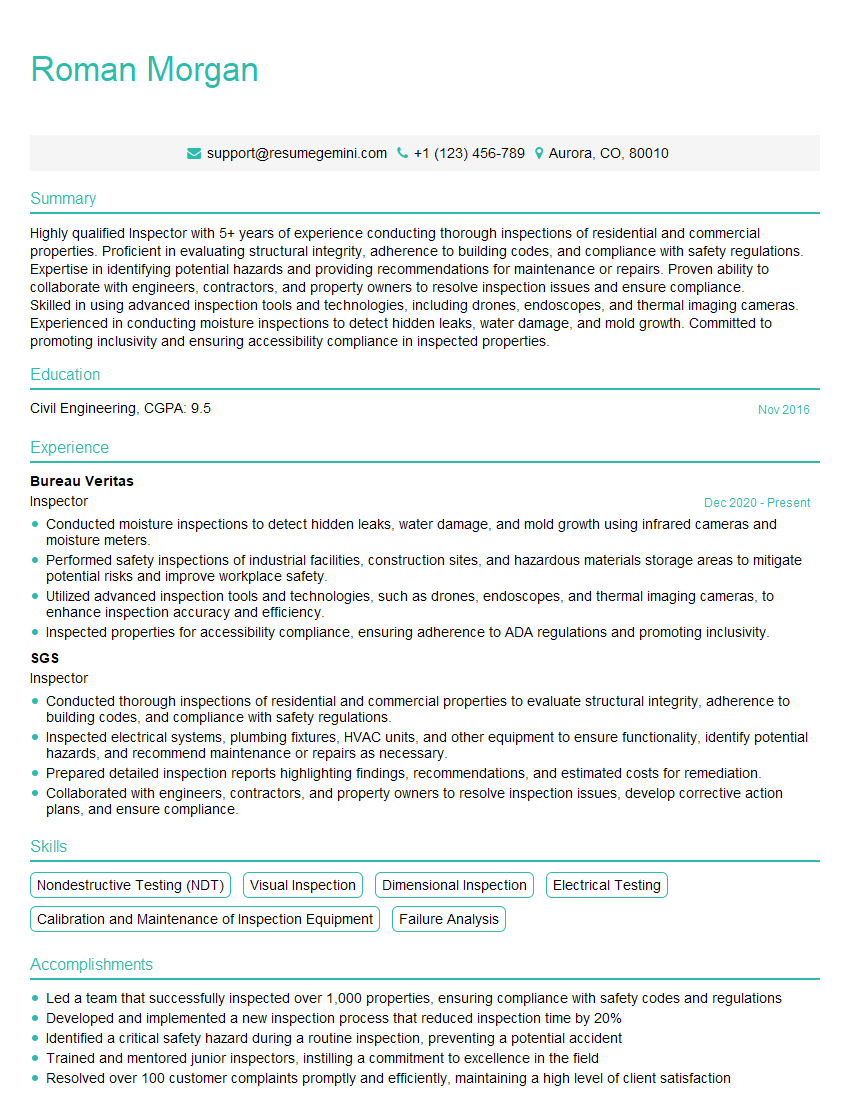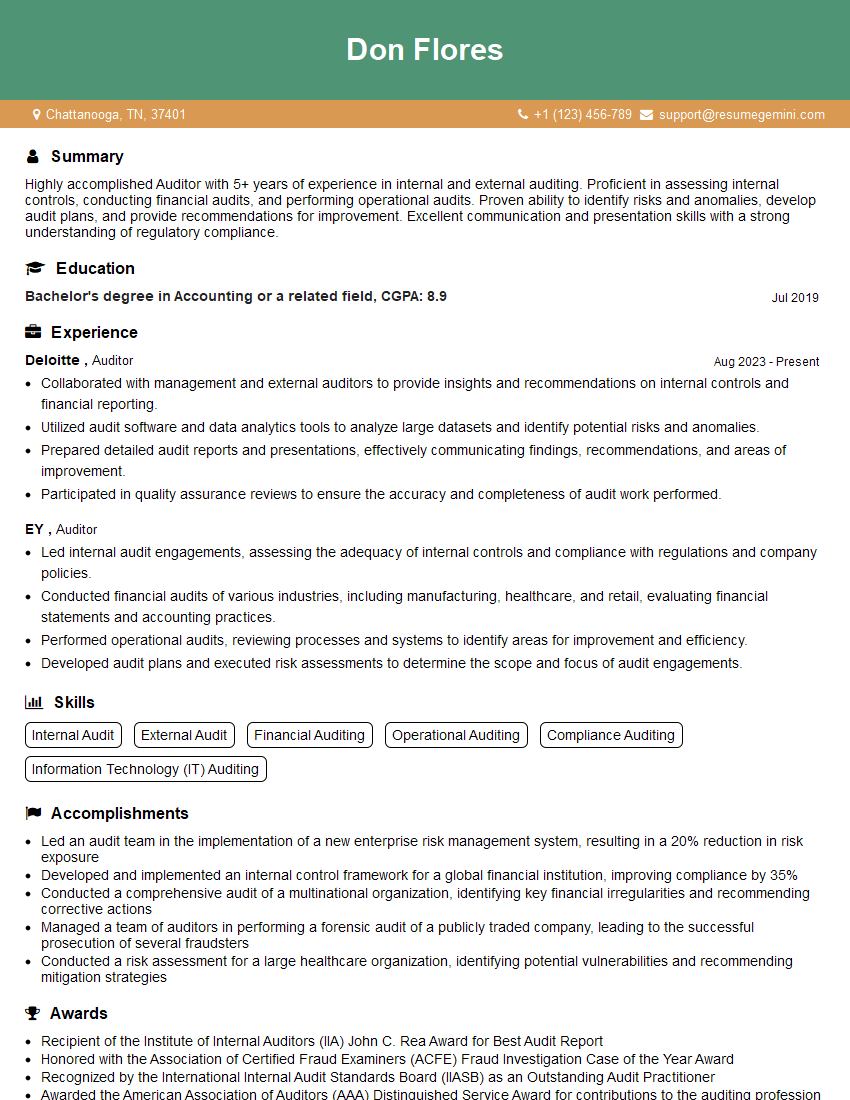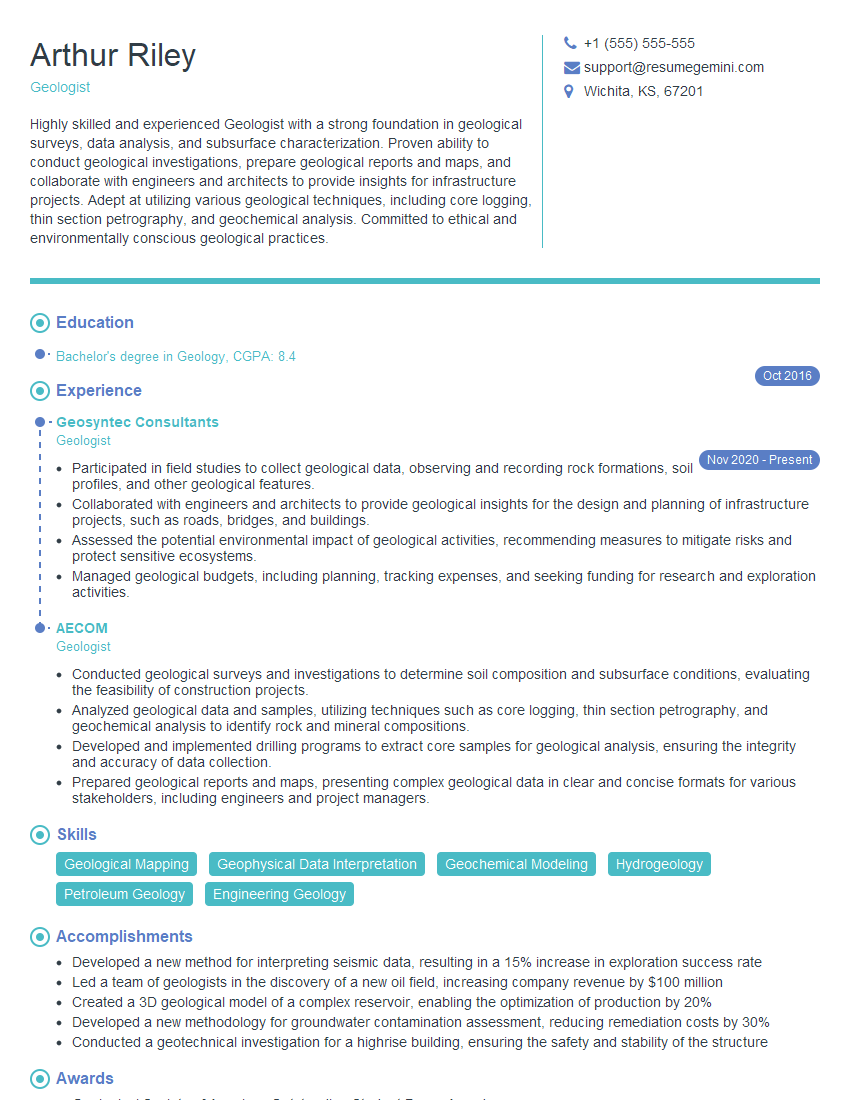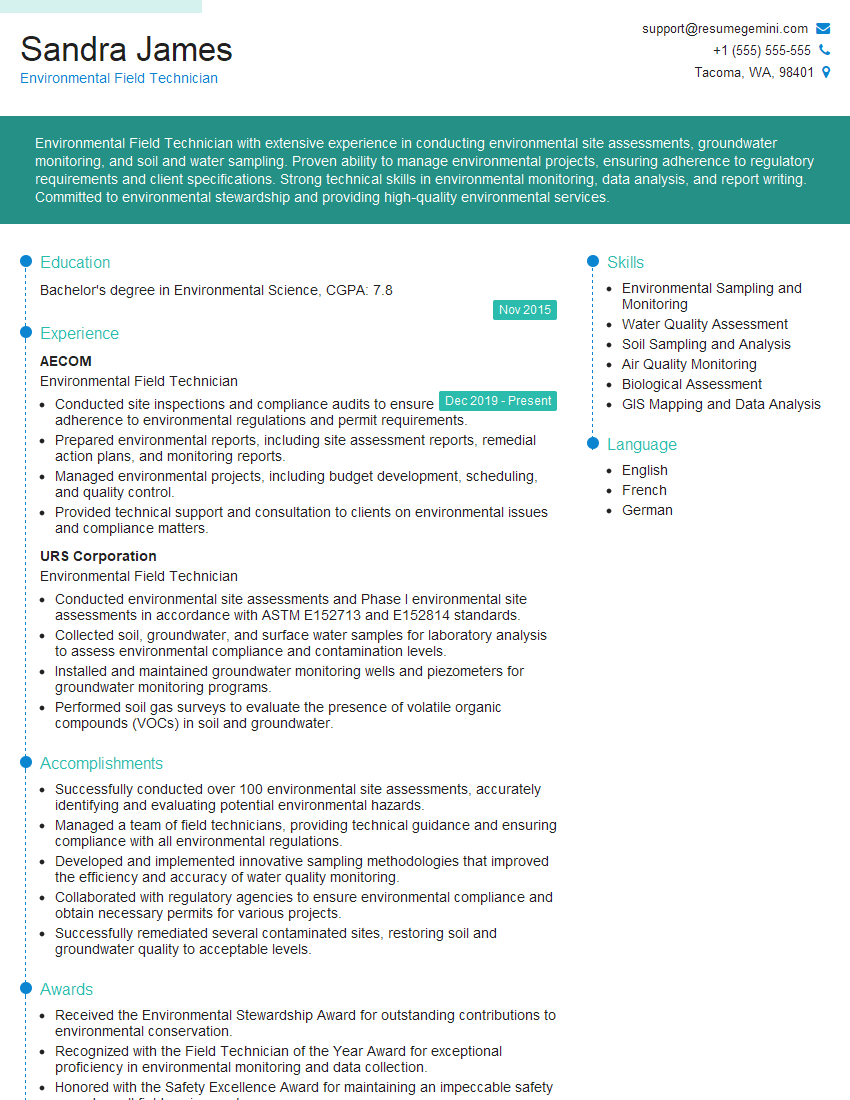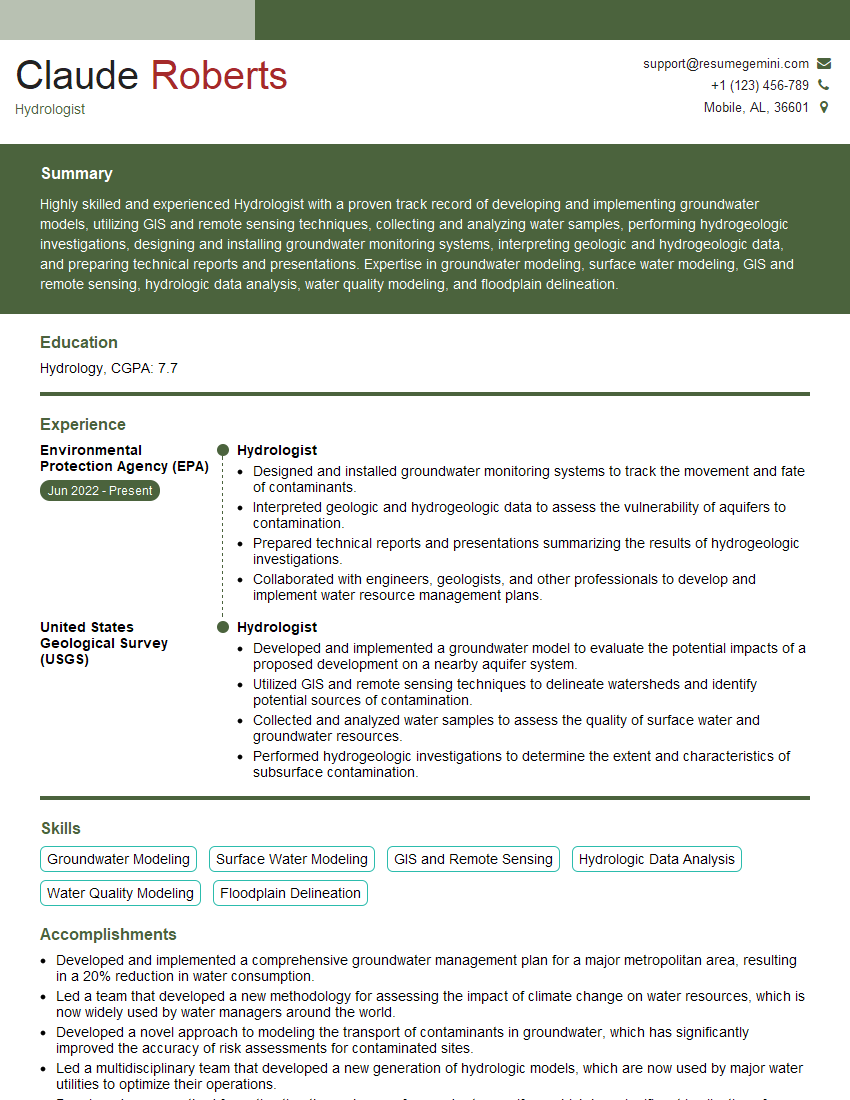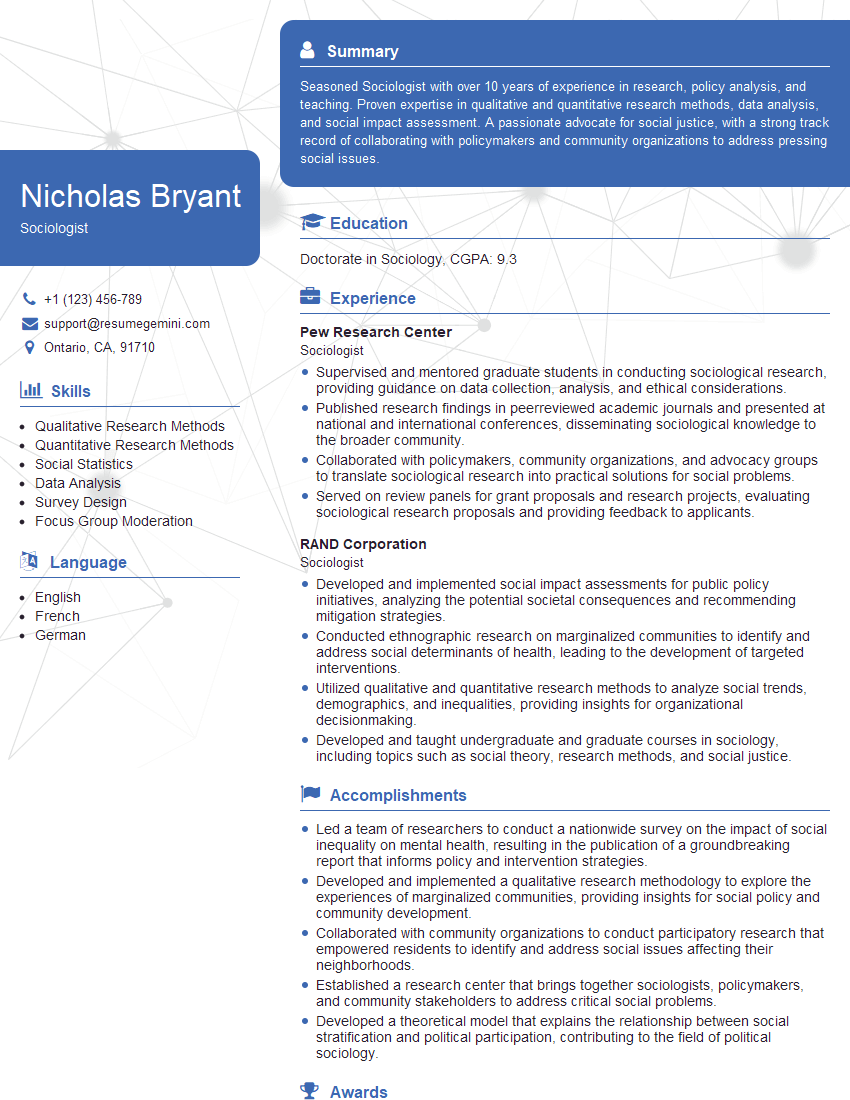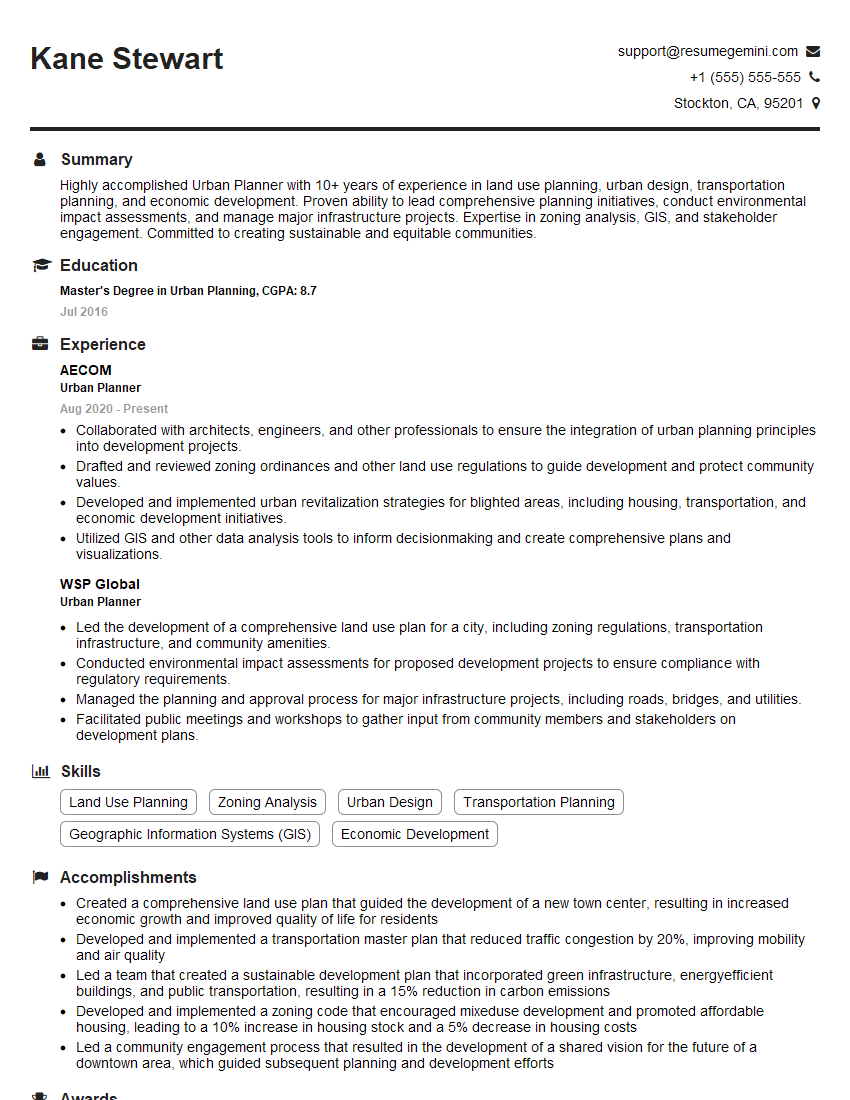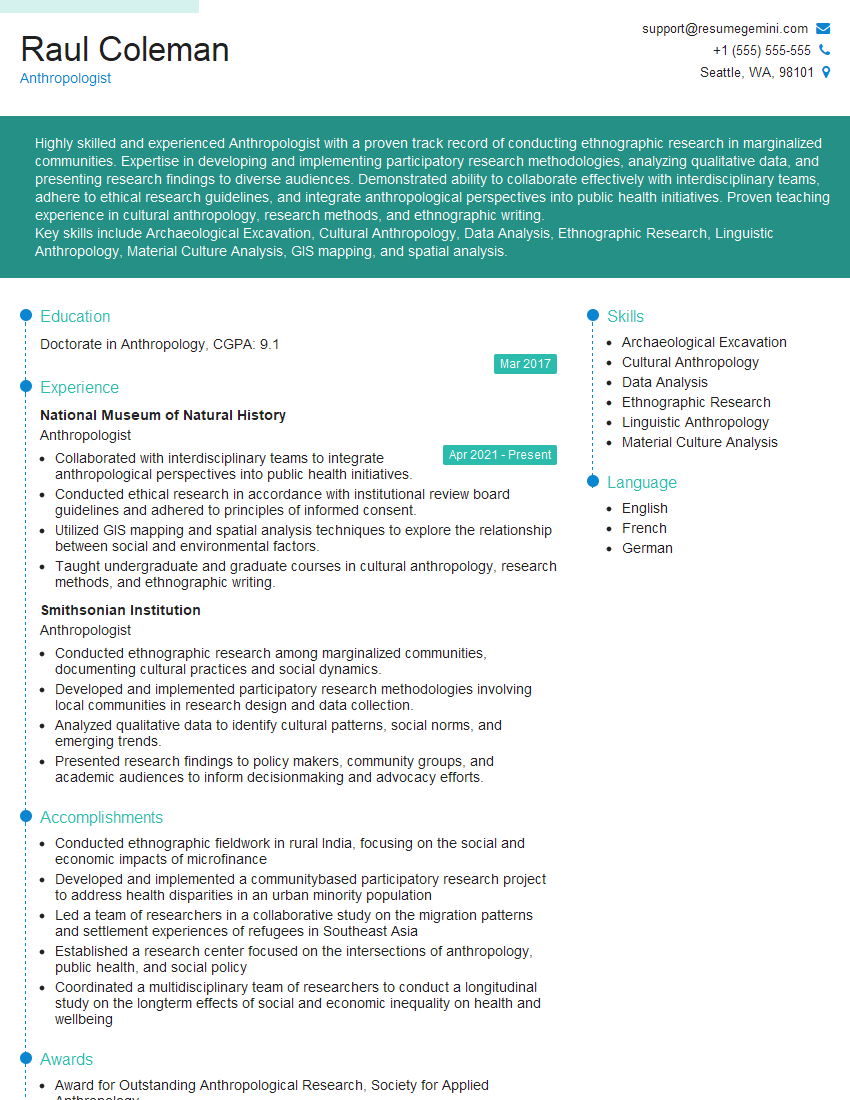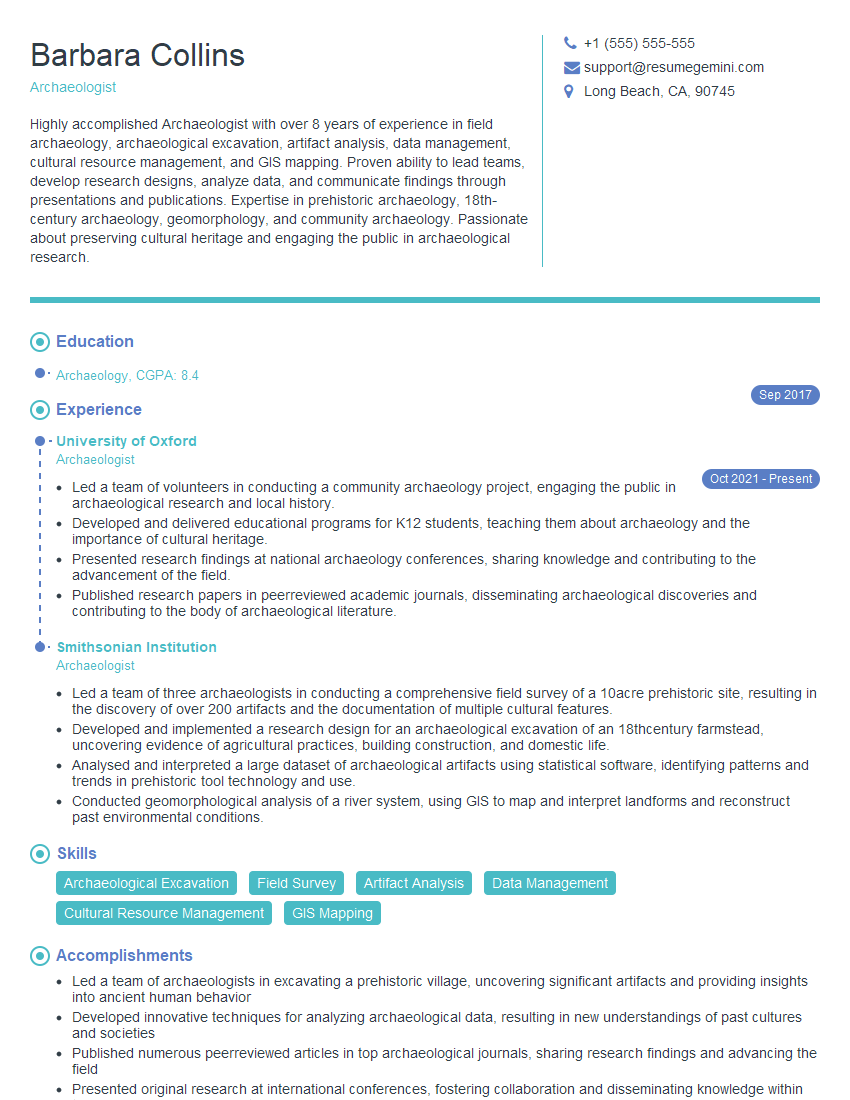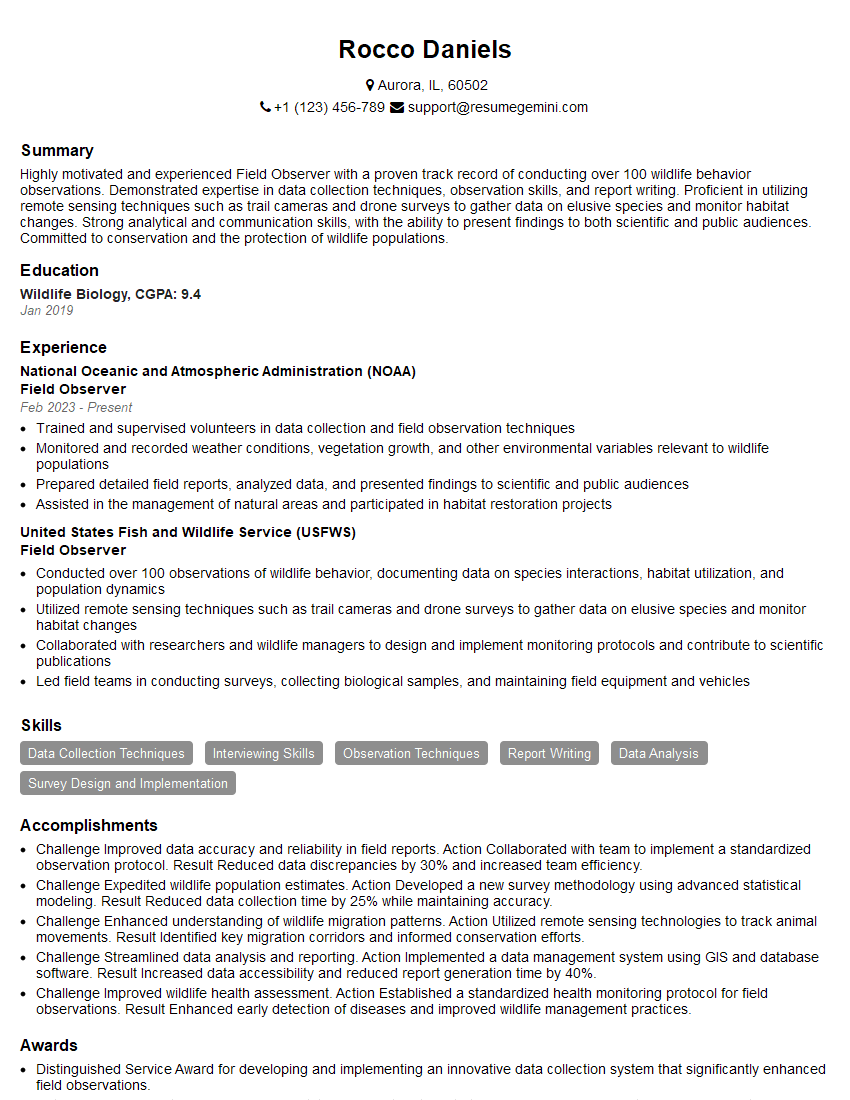Cracking a skill-specific interview, like one for Field Observation, requires understanding the nuances of the role. In this blog, we present the questions you’re most likely to encounter, along with insights into how to answer them effectively. Let’s ensure you’re ready to make a strong impression.
Questions Asked in Field Observation Interview
Q 1. Describe your experience with different field observation methods (e.g., participant observation, non-participant observation).
Field observation encompasses various methods, each offering unique perspectives. Participant observation involves immersing oneself within the observed group, actively participating in their activities while collecting data. This approach provides rich, nuanced insights into the group’s culture and dynamics. For example, during a study on the work culture of a tech startup, I spent three months working as an intern, attending meetings, participating in team projects, and observing informal interactions. This allowed me to understand the unspoken rules and dynamics influencing productivity and team cohesion. In contrast, non-participant observation entails observing from a distance, without directly engaging in the activities. This minimizes the potential for observer bias but might limit the depth of understanding. For instance, while studying chimpanzee behavior in a national park, I used binoculars and a hidden observation post, meticulously recording their activities without interfering. This ensured unbiased data on their natural interactions but lacked the intimate understanding achievable through participation.
Further, I’ve also utilized structured observation, where a pre-defined checklist guides data collection, ensuring consistency. This is particularly useful in standardized studies or when comparing findings across different sites or time periods. For example, in a study on traffic patterns, I used a standardized form to note down the type, speed, and direction of vehicles at pre-determined intervals. This provided quantifiable data for analysis.
Q 2. How do you ensure the reliability and validity of your field observations?
Ensuring reliability and validity in field observation is crucial. Reliability refers to the consistency of the observations, while validity ensures they accurately measure what they intend to. To enhance reliability, I employ multiple strategies. First, I use detailed observation protocols and checklists, making the process consistent across different observation sessions and observers. Second, I utilize inter-rater reliability checks, where multiple observers independently record observations, allowing comparison and calculation of agreement percentages. Discrepancies highlight areas needing clarification or refinement in the protocols.
Validity is improved through triangulation. This means using multiple data sources, such as combining field observations with interviews, document analysis, or surveys. For example, my observations of classroom dynamics were corroborated by teacher interviews and student questionnaires, providing a more holistic picture. Member checking, where findings are shared with the observed group for feedback, further strengthens validity. This allows for corrections of misinterpretations or biases.
Q 3. Explain your approach to data recording and management during field observations.
Data recording and management are critical. I usually employ a combination of methods. Detailed field notes, written immediately after observation sessions, capture rich qualitative data. I utilize a structured format, noting the date, time, location, and specific details of observed behaviours. These notes are regularly reviewed and refined to ensure accuracy and clarity.
Furthermore, I employ technological tools. Digital audio or video recordings can capture detailed information, especially when studying dynamic events. Photos can document specific aspects of the environment or behaviour. However, it’s vital to obtain informed consent before recording individuals. The recorded data is then transcribed, coded, and stored securely, adhering to ethical guidelines and data protection regulations.
Data management involves using organizational tools like spreadsheets or qualitative data analysis software (e.g., NVivo) to manage and analyze the collected information. This facilitates data retrieval, coding, and comparison across multiple observation sessions, ensuring a systematic and organized approach.
Q 4. How do you handle unexpected challenges or obstacles during field observations?
Unexpected challenges are inherent in field observation. I’ve encountered situations ranging from equipment malfunctions to unexpected changes in the research setting. My approach involves flexibility and adaptability. For instance, when my recording device malfunctioned during a critical observation, I immediately switched to detailed hand-written notes, maintaining data collection continuity.
Unexpected changes necessitate adjustments to the observation plan. If the behaviour I’m observing changes significantly, I update my field notes, reflecting this shift and adapting my data collection strategy as needed. If access to a site is unexpectedly denied, I explore alternative research locations or methods, ensuring data collection continues. Regular reflection on challenges and modifications are documented, improving research design in future studies.
Q 5. What ethical considerations are crucial in field observation research?
Ethical considerations are paramount. Informed consent is crucial – participants must understand the purpose of the observation, how data will be used, and their right to withdraw. Anonymity and confidentiality must be protected, avoiding any identification of participants in reports or publications. Researchers must be mindful of cultural sensitivities and avoid causing harm or disruption to the observed group. For instance, while studying a remote community, I ensured that all interactions were respectful of their customs and traditions and that my presence did not interfere with their daily lives.
Ethical review boards should review research protocols to ensure ethical compliance. This review process helps to identify and address potential ethical conflicts before the commencement of the research. Transparency and integrity are crucial – accurately representing findings and acknowledging any limitations are vital.
Q 6. How do you maintain objectivity and avoid bias in your observations?
Maintaining objectivity and minimizing bias is crucial. Employing structured observation methods, with pre-defined categories and checklists, helps reduce subjectivity. Regular self-reflection on potential biases is also important. I critically evaluate my own preconceived notions and assumptions to prevent them from influencing the interpretation of observations.
Triangulation, as mentioned earlier, helps to offset bias by using multiple data sources. Seeking feedback from other observers or colleagues provides an external perspective and helps identify potential biases. Careful analysis of the data, ensuring consistent application of coding and interpretation schemes, minimizes bias in the data analysis stage.
Q 7. Describe your experience using specific observation tools or technologies (e.g., GPS, cameras, recording devices).
I have extensive experience using various observation tools and technologies. GPS devices are invaluable for accurately recording locations, particularly in geographical studies. Cameras, both still and video, allow for documentation of behaviours and environmental contexts. Audio recording devices capture detailed verbal interactions. However, ethical considerations, as discussed, are paramount when employing recording devices.
In one study, I used a combination of GPS tracking, video recording, and time-lapse photography to monitor the movement patterns of endangered bird species. GPS data provided precise locations, video recordings captured behavioural interactions, and time-lapse photography documented environmental changes. The combination ensured a rich dataset for analysis. Software such as GIS programs is often crucial in analyzing this combined data.
Q 8. How do you select an appropriate sampling strategy for your field observations?
Selecting the right sampling strategy for field observations is crucial for ensuring the data collected is representative and allows for valid conclusions. The best strategy depends heavily on the research question, the population being studied, and available resources. There isn’t a one-size-fits-all approach.
- Random Sampling: Every member of the population has an equal chance of being selected. This is ideal for minimizing bias, but can be challenging in practice, especially in geographically dispersed populations.
- Systematic Sampling: Selecting individuals at regular intervals (e.g., every tenth person). This is efficient but could be problematic if there’s a pattern in the population that aligns with the sampling interval.
- Stratified Sampling: Dividing the population into subgroups (strata) based on relevant characteristics (e.g., age, location) and then randomly sampling from each stratum. This ensures representation from all subgroups.
- Convenience Sampling: Selecting individuals who are readily available. This is easy but introduces significant bias and limits generalizability.
- Purposive Sampling: Selecting individuals based on specific criteria relevant to the research question. Useful when focusing on specific characteristics or cases.
For example, studying bird migration patterns might utilize systematic sampling along a transect line, while researching customer behavior in a mall might employ stratified sampling based on age groups and time of day.
Q 9. How do you analyze and interpret qualitative data collected through field observations?
Analyzing qualitative data from field observations involves a systematic process of organizing, interpreting, and drawing meaning from the collected descriptive information. It’s not about numbers, but about themes, patterns, and nuances.
- Transcription and Organization: Field notes are often transcribed and organized chronologically or thematically. Software like NVivo can assist in managing large datasets.
- Coding: Identifying recurring themes, concepts, or patterns in the data. This might involve assigning codes to specific observations.
- Categorization: Grouping similar codes into broader categories to create a coherent framework for analysis.
- Interpretation: Drawing inferences and conclusions based on the identified categories and themes. This involves examining relationships between categories and exploring potential explanations for observed patterns.
- Validation: Checking the accuracy and reliability of interpretations by comparing them to other data sources or by seeking feedback from peers.
Think of it like piecing together a puzzle. Each observation is a piece, and the goal is to create a complete picture that reveals the underlying meaning and structure.
Q 10. How do you deal with observer effects during your observations?
Observer effects, also known as reactivity, refer to changes in the behavior of individuals being observed due to their awareness of being watched. This can significantly bias the observations.
- Habituation: Repeated visits to the observation site allow subjects to become accustomed to the observer’s presence, reducing reactivity. This requires patience and careful planning.
- Unobtrusive Observation: Employing techniques like hidden observation (ethically permissible and legally compliant) or participating observation (becoming part of the group) to minimize the impact of the observer.
- Blending in: Wearing inconspicuous clothing and adopting a low-key demeanor can help reduce the observer effect.
- Delayed recording: Taking notes after leaving the observation site to avoid immediate disruption. This helps reduce the influence of the observer’s presence.
- Reflexivity: Acknowledging and reflecting on the observer’s own biases and influence on the observations. This involves critical self-reflection and consideration of potential biases.
For instance, studying primate behavior in the wild might involve habituation techniques, while observing classroom dynamics might benefit from participant observation.
Q 11. How do you ensure the safety and security of yourself and your equipment during field work?
Safety and security during fieldwork are paramount. Negligence can lead to injury, equipment loss, or even worse.
- Risk Assessment: Conducting a thorough risk assessment before fieldwork, identifying potential hazards (e.g., wildlife, weather, terrain, equipment malfunction), and developing mitigation strategies.
- Appropriate Clothing and Gear: Wearing suitable clothing and protective gear (e.g., sturdy footwear, high-visibility clothing, safety helmets) for the environment and activities.
- Communication Plan: Establishing a communication plan, including informing someone of the fieldwork location, duration, and expected return time. Consider satellite phones or personal locator beacons in remote areas.
- First-Aid and Emergency Kit: Carrying a well-stocked first-aid kit and understanding basic first-aid procedures. Knowing emergency contact numbers is essential.
- Equipment Maintenance: Ensuring equipment is well-maintained and in good working order before fieldwork. Carrying backup equipment is prudent.
In one study, I conducted fieldwork in a remote rainforest. Our team prepared extensively, including obtaining necessary permits, having satellite communication, and attending wilderness first-aid training.
Q 12. Describe a time you had to adapt your observation plan due to unforeseen circumstances.
During a study on urban bird populations, I planned to observe bird activity at a specific park over a month using a systematic sampling method. Unexpectedly, a large-scale construction project began near the park, disrupting bird behavior and making observations invalid.
I had to adapt by:
- Identifying alternative sites: I located nearby parks with less disruption.
- Adjusting the sampling strategy: I switched to purposive sampling, focusing on specific bird species and locations less affected by the construction.
- Modifying data collection methods: I supplemented direct observation with audio recordings to capture bird activity even in noisy environments.
- Documenting changes: I meticulously documented the construction activity and its potential impact on my observations.
This experience highlighted the importance of flexibility and adaptability in field observation, emphasizing the need to plan for unforeseen circumstances and adjust strategies as needed.
Q 13. What software or tools are you familiar with for data analysis related to field observation?
Several software tools and programs aid in data analysis related to field observation. The choice depends on the nature of the data and the analytical goals.
- NVivo: Qualitative data analysis software for managing, coding, and analyzing textual and visual data. Useful for organizing field notes and identifying themes.
- ATLAS.ti: Another powerful qualitative data analysis software with similar capabilities to NVivo.
- Excel/Spreadsheets: Useful for managing quantitative data collected during field observations (e.g., counts, measurements). Simple statistical analysis can be done within spreadsheets.
- R/Python: Programming languages with extensive statistical packages for more sophisticated analysis, including spatial analysis if location data is collected.
- GIS Software (e.g., ArcGIS, QGIS): Essential when spatial data is involved. Useful for mapping observations, analyzing spatial patterns, and creating visualizations.
For example, in a study involving spatial distribution of plants, GIS software would be invaluable to map the distribution and analyze the patterns.
Q 14. How do you synthesize your field observations with other data sources (e.g., interviews, documents)?
Synthesizing field observations with other data sources like interviews and documents is crucial for building a richer understanding of the phenomenon being studied. It allows for triangulation of data, strengthening the validity of findings.
- Comparison and Contrast: Comparing and contrasting field observations with data from interviews and documents to identify convergences and divergences. This can help resolve discrepancies or highlight unexpected findings.
- Contextualization: Using interviews and documents to provide context and background information for field observations, enriching the interpretations.
- Triangulation: Using different data sources to confirm findings, enhancing the credibility and reliability of conclusions.
- Data Integration: Integrating data from different sources to create a more holistic and comprehensive understanding of the phenomenon.
- Narrative Development: Combining field observations, interview transcripts, and documents to construct a coherent and compelling narrative that tells the story of the research findings.
For example, if studying community attitudes toward a new park, field observations of park usage could be complemented by interviews with residents and documents like park planning reports to gain a holistic understanding.
Q 15. Explain your experience with different types of field notes (e.g., descriptive, reflective, analytical).
Field notes are the lifeblood of any field observation project. I’ve extensively used three primary types: descriptive, reflective, and analytical. Descriptive notes focus on a factual, objective record of what is observed, akin to a journalist’s account. For example, I might note, “At 10:15 AM, three children were playing tag near the oak tree, two girls and one boy. The girl in the blue shirt tripped and fell.” Reflective notes delve into my personal reactions and interpretations of what I’ve observed. This might include thoughts like, “The children’s laughter seemed genuine, but the boy’s hesitancy to help the fallen girl was intriguing. This could reflect dynamics within their peer group.” Finally, analytical notes synthesize my observations and reflections to draw conclusions or identify patterns. I might analyze the children’s play patterns, drawing connections to theories on social interaction or gender roles. For instance, I could write: “The observed interaction between the children supports existing research showing differences in play styles between genders at this age.” I typically integrate all three note-taking styles, ensuring a comprehensive record of the field observation.
Career Expert Tips:
- Ace those interviews! Prepare effectively by reviewing the Top 50 Most Common Interview Questions on ResumeGemini.
- Navigate your job search with confidence! Explore a wide range of Career Tips on ResumeGemini. Learn about common challenges and recommendations to overcome them.
- Craft the perfect resume! Master the Art of Resume Writing with ResumeGemini’s guide. Showcase your unique qualifications and achievements effectively.
- Don’t miss out on holiday savings! Build your dream resume with ResumeGemini’s ATS optimized templates.
Q 16. How do you ensure the confidentiality and anonymity of participants in your field observations?
Confidentiality and anonymity are paramount. My process begins with informed consent (discussed in the next answer), where I clearly state that all data will be anonymized and used only for research purposes. Instead of using real names, I use pseudonyms – for instance, instead of “John Smith,” I might use “Participant A.” I also avoid identifying details like specific locations, unless absolutely necessary for contextualizing the observation, and then I will alter details to make them unrecognizable. For example, instead of saying “the observation took place at the corner of Elm Street and Oak Avenue,” I might write “the observation took place at a busy intersection in a residential neighborhood.” All data is securely stored, either on password-protected computers or using encryption methods, further safeguarding participant privacy. I meticulously remove all personally identifying information before data analysis or reporting.
Q 17. Describe your process for obtaining informed consent from participants.
Obtaining informed consent is a crucial ethical step. I start by explaining the purpose of the study in simple, accessible language. I detail the observation methods, highlighting what they will be involved in and emphasizing that participation is voluntary and they can withdraw at any time without penalty. I clearly describe how their data will be used and how their confidentiality and anonymity will be protected. I ensure the consent form is written in plain language, easily understandable by participants, and is available in their preferred language. I allow ample time for questions and address all their concerns before obtaining their written consent. If participants are minors, I obtain consent from both the child and a legal guardian. I always prioritize transparency and respect for participant autonomy. An example consent form would include sections on study purpose, methods, risks and benefits, data handling, participant rights, and contact information for researchers. It needs to be signed and dated by the participant and myself.
Q 18. How do you manage your time effectively during fieldwork?
Effective time management in fieldwork is crucial. Before beginning fieldwork, I meticulously plan the observation schedule, considering factors like the availability of participants, optimal observation times, and potential travel time. I use a combination of scheduling tools and physical planners to keep track of my activities. I set clear goals for each observation session to ensure I focus on the key aspects and avoid getting overwhelmed. During the fieldwork, I might use timers to break down observations into manageable segments, preventing fatigue and improving focus. I also build in buffer time between observation sessions to account for unexpected delays or events. Regular breaks are crucial for maintaining energy levels and ensuring objectivity. Post-fieldwork, I allocate dedicated time for data entry and analysis, integrating this into my overall schedule. Consistent scheduling helps maximize efficiency and minimize stress during the entire process.
Q 19. How do you prioritize observations when multiple events occur simultaneously?
When multiple events occur simultaneously, prioritization is key. My approach involves a combination of pre-determined observational goals and on-the-spot judgment. Prior to the observation, I identify my key research questions, guiding my focus on the most relevant events. During the observation, I use a hierarchical prioritization scheme. I might note a brief description of all events in my descriptive notes, then focus detailed observations on the events most pertinent to my research questions. If possible, I incorporate systematic sampling techniques – for instance, focusing on events occurring at regular intervals. I might also employ the use of video or audio recordings (with appropriate consent), allowing a more thorough review of all events later. Post-observation, I review the notes and recordings to ensure all significant observations are captured, even those that were secondary during the actual event.
Q 20. Describe your experience with inter-observer reliability checks.
Inter-observer reliability is essential for ensuring the validity of field observations. I regularly employ this strategy by working with a second observer trained in the same observation methods. We independently observe the same event or setting, and then compare our observations afterwards using a pre-determined coding scheme or checklist. We discuss any discrepancies in our observations and work towards a consensus. We can calculate inter-observer reliability using statistical measures like Cohen’s kappa, which quantifies the level of agreement beyond chance. This process allows us to identify and address any biases or inconsistencies in our observation techniques, leading to more objective and reliable data. The resulting reliability coefficient provides a quantitative measure of agreement, helping us assess the accuracy and validity of our observations.
Q 21. How do you handle conflicting observations or data?
Conflicting observations or data demand careful attention. First, I review my notes and any recordings for errors or inaccuracies. I check for potential biases that might have influenced my observations. Next, I seek to understand the reasons for the discrepancies. This could involve revisiting the site, interviewing other individuals involved, or consulting relevant literature. I might also consider the limitations of my observation methods and acknowledge potential sources of error in my analysis. Often, a triangulation approach helps – combining data from multiple sources (observations, interviews, documents) allows for a more nuanced understanding of the situation and a resolution to the conflict. Finally, I may use qualitative data analysis techniques to identify patterns and themes that help integrate apparently contradictory observations, leading to a more thorough interpretation. In my final report, I acknowledge the existence of conflicting observations and clearly explain how I have attempted to resolve them.
Q 22. What are the limitations of field observation as a research method?
Field observation, while a powerful qualitative research method, has inherent limitations. The most significant is observer bias, where the researcher’s preconceptions influence what they see and record. This can lead to inaccurate or incomplete data. Another limitation is reactivity – the presence of the observer can alter the behavior of the subjects being observed, leading to artificial or unrepresentative data. For example, observing classroom behavior might cause students to act differently than they normally would.
Furthermore, field observation is often time-consuming and labor-intensive, requiring significant time commitment for data collection and analysis. It can be challenging to replicate findings due to the unique and contextual nature of observations. Finally, the method’s subjectivity makes it difficult to generalize findings to larger populations, and it’s challenging to establish causal relationships between observed events.
- Limited generalizability: Findings are often context-specific.
- Difficulty in establishing causality: Observation shows correlation, not necessarily causation.
- Ethical considerations: Informed consent and privacy need careful consideration, especially in sensitive settings.
Q 23. How do you address potential observer bias in your data analysis?
Addressing observer bias is crucial for maintaining the integrity of field observation data. I employ several strategies to mitigate this. Firstly, I use a structured observation protocol, a pre-defined checklist or coding scheme that guides my observations and minimizes the impact of subjective interpretations. This ensures consistency and reduces the likelihood of focusing only on aspects aligning with my hypotheses.
Secondly, I utilize inter-observer reliability checks. This involves having multiple observers independently record observations of the same event or phenomenon. Comparing and discussing discrepancies helps identify and refine coding schemes, improving objectivity. For instance, in a study on pedestrian behavior, multiple observers could independently code pedestrian interactions at a busy intersection, then compare notes and resolve any disagreements.
Thirdly, I maintain detailed and thorough field notes, including both objective descriptions and reflective notes on my potential biases. This allows me to later critically evaluate the potential influence of my own perspectives on the data interpretation. Finally, I use triangulation, incorporating data from other sources like interviews or surveys to validate or corroborate findings from field observations.
Q 24. Describe your experience with different types of field settings (e.g., urban, rural, natural environments).
My experience encompasses diverse field settings. I’ve conducted observations in bustling urban centers, studying pedestrian flow and social interactions in public spaces like parks and markets. This involved navigating crowds, understanding diverse cultural contexts, and ensuring personal safety. I’ve also worked in rural communities, where the focus shifted to observing agricultural practices, community dynamics, and the impact of environmental changes on livelihoods. The challenge here was building trust within the community and adapting to more isolated and less structured environments.
I’ve also had extensive experience in natural environments, conducting observations of wildlife behavior and ecological processes. This required specialized training in data collection techniques, such as using camera traps or conducting systematic transects. The unique challenges here included weather conditions, remote locations, and ensuring minimal disturbance to the environment.
Each setting presented unique logistical and methodological challenges, requiring adaptability and the implementation of appropriate safety and ethical protocols. The key was to remain flexible and responsive to the demands of the specific context while maintaining the rigor and consistency of my observational techniques.
Q 25. Explain your familiarity with relevant regulations and guidelines for fieldwork in your specific field.
My work adheres to strict ethical and regulatory guidelines, which vary depending on the field setting and research subject. For human subjects research, I always ensure compliance with IRB (Institutional Review Board) protocols, obtaining informed consent and maintaining participant confidentiality. This involves carefully designing study protocols, explaining the research purpose clearly to participants, and assuring them of their right to withdraw at any time.
In natural environments, I’m familiar with and adhere to regulations regarding wildlife observation and protection. This includes obtaining necessary permits, understanding protected species regulations, and minimizing any disturbance to the ecosystem. In both human and environmental settings, data security and responsible data management practices are crucial to maintaining ethical integrity. For example, when studying endangered species, I would ensure minimal disruption to their habitats, always prioritize their well-being, and strictly follow all relevant permits and regulations.
Q 26. How do you ensure the accuracy and completeness of your field data?
Ensuring data accuracy and completeness is paramount. This starts with careful planning. Before fieldwork, I develop a detailed observation protocol specifying the data to be collected, the methods of recording it, and the criteria for identifying and recording events. This reduces ambiguity and improves consistency. I use standardized data collection tools – such as checklists, coding schemes, and audio/video recording – to minimize subjective interpretation and enable repeatability.
During fieldwork, I regularly check my data for consistency and completeness. I maintain a detailed field journal, documenting any methodological challenges or unexpected events that may affect data quality. After data collection, I carefully review all records, and use quality control measures like inter-observer checks (as mentioned earlier) to ensure accuracy and consistency. In cases of missing data, I’ll assess whether it’s possible to retrieve the information, or consider the implications of data gaps in the interpretation and reporting of findings.
Q 27. Describe your experience working independently and as part of a team in a field setting.
I have extensive experience working both independently and collaboratively in field settings. Independent work often involves conducting initial site assessments, setting up equipment, and conducting preliminary observations. This necessitates self-motivation, problem-solving skills, and the ability to adapt to unexpected challenges. For example, during a solo birdwatching expedition, I had to troubleshoot malfunctioning equipment in a remote location, relying on my resourcefulness to adapt and continue the observation.
Teamwork is crucial for larger-scale projects involving multiple observation sites or the need for specialized skills. In these instances, I excel in coordinating fieldwork activities, sharing data, and contributing to collective analysis. I find team dynamics rewarding, promoting diverse perspectives and fostering innovative problem-solving strategies. For example, during a community-based participatory research project, collaborative teamwork enabled us to collect more comprehensive and nuanced data by leveraging each team member’s strengths and perspectives.
Key Topics to Learn for Field Observation Interview
- Observational Methods: Understand various techniques like participant observation, non-participant observation, structured vs. unstructured observation, and their respective strengths and weaknesses. Consider ethical implications in each.
- Data Collection and Recording: Learn how to effectively collect data using field notes, audio/video recording, and other relevant tools. Practice summarizing observations concisely and accurately.
- Data Analysis and Interpretation: Explore qualitative data analysis techniques, such as thematic analysis and coding, to identify patterns and draw meaningful conclusions from your observations. Be prepared to discuss your analytical approach.
- Contextual Understanding: Demonstrate your ability to interpret observations within their broader social, cultural, and environmental contexts. This involves recognizing biases and considering multiple perspectives.
- Problem-Solving and Critical Thinking: Practice applying your observational skills to identify problems, develop hypotheses, and propose solutions based on your findings. Be ready to discuss challenges encountered during field observation and how you overcame them.
- Ethical Considerations: Understand and be prepared to discuss ethical issues related to informed consent, confidentiality, privacy, and potential biases in observation. This is crucial for demonstrating professional conduct.
- Reporting and Presentation: Practice presenting your findings clearly and concisely, both orally and in written reports. Consider the different audiences you might address and tailor your communication accordingly.
Next Steps
Mastering field observation skills is crucial for career advancement in numerous fields, opening doors to impactful roles requiring keen analytical abilities and a strong understanding of human behavior. To maximize your job prospects, crafting a strong, ATS-friendly resume is paramount. ResumeGemini can significantly enhance your resume-building experience, helping you create a professional document that showcases your skills and experience effectively. Examples of resumes tailored to Field Observation are available to help guide you in this process.
Explore more articles
Users Rating of Our Blogs
Share Your Experience
We value your feedback! Please rate our content and share your thoughts (optional).
What Readers Say About Our Blog
Hello,
We found issues with your domain’s email setup that may be sending your messages to spam or blocking them completely. InboxShield Mini shows you how to fix it in minutes — no tech skills required.
Scan your domain now for details: https://inboxshield-mini.com/
— Adam @ InboxShield Mini
Reply STOP to unsubscribe
Hi, are you owner of interviewgemini.com? What if I told you I could help you find extra time in your schedule, reconnect with leads you didn’t even realize you missed, and bring in more “I want to work with you” conversations, without increasing your ad spend or hiring a full-time employee?
All with a flexible, budget-friendly service that could easily pay for itself. Sounds good?
Would it be nice to jump on a quick 10-minute call so I can show you exactly how we make this work?
Best,
Hapei
Marketing Director
Hey, I know you’re the owner of interviewgemini.com. I’ll be quick.
Fundraising for your business is tough and time-consuming. We make it easier by guaranteeing two private investor meetings each month, for six months. No demos, no pitch events – just direct introductions to active investors matched to your startup.
If youR17;re raising, this could help you build real momentum. Want me to send more info?
Hi, I represent an SEO company that specialises in getting you AI citations and higher rankings on Google. I’d like to offer you a 100% free SEO audit for your website. Would you be interested?
Hi, I represent an SEO company that specialises in getting you AI citations and higher rankings on Google. I’d like to offer you a 100% free SEO audit for your website. Would you be interested?
good
